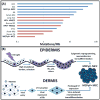Are there multiple cells of origin of Merkel cell carcinoma?
- PMID: 29321666
- PMCID: PMC5854515
- DOI: 10.1038/s41388-017-0073-3
Are there multiple cells of origin of Merkel cell carcinoma?
Abstract
Merkel cell carcinoma (MCC) is a rare but lethal cancer with the highest case-by-case fatality rate among all skin cancers. Eighty percent of cancers are associated with the Merkel cell polyomavirus (MCPyV). Twenty percent of MCCs are virus negative. Recent epidemiological data suggest that there are important, clinically relevant differences between these two subtypes of MCC. Recent studies in cancer genomics, mouse genetics, and virology experiments have transformed our understanding of MCC pathophysiology. Importantly, dramatic differences in the genetics of these two MCC subtypes suggest fundamental differences in their pathophysiology. We review these recent works and find that they provocatively suggest that MCPyV-positive and MCPyV-negative MCCs arise from two different cells of origin: the MCPyV-negative MCC from epidermal keratinocytes and the MCPyV-positive MCC from dermal fibroblasts. If true, this would represent the first cancer that we are aware of that evolves from cells of origin from two distinct germ layers: MCPyV-negative MCCs from ectodermal keratinocytes and MCPyV-positive MCCs from mesodermal fibroblasts. Future epigenetic experiments may prove valuable in confirming these distinct lineages for these MCC subtypes, especially for the clinical importance the cell of origin has on MCC treatment and prevention.
Conflict of interest statement
The authors state no conflict of interest.
Figures

References
-
- Elston D, Ferringer T, Ko CJ, Peckham S, High WA, DiCaudo DJ. Dermatopathology. Elsevier Health Sciences; 2013.
-
- Lemasson G, Coquart N, Lebonvallet N, Boulais N, Galibert MD, Marcorelles P, et al. Presence of putative stem cells in Merkel cell carcinomas. J Eur Acad Dermatol Venereol. 2012;26:789–795. - PubMed
-
- Visscher D, Cooper PH, Zarbo RJ, Crissman JD. Cutaneous neuroendocrine (Merkel cell) carcinoma: an immunophenotypic, clinicopathologic, and flow cytometric study. Mod Pathol. 1989;2:331–338. - PubMed
-
- Zur Hausen A, Rennspiess D, Winnepenninckx V, Speel EJ, Kurz AK. Early B-cell differentiation in Merkel cell carcinomas: clues to cellular ancestry. Cancer Res. 2013;73:4982–4987. - PubMed
Publication types
MeSH terms
Grants and funding
LinkOut - more resources
Full Text Sources
Other Literature Sources
Medical
Molecular Biology Databases

